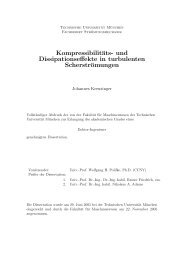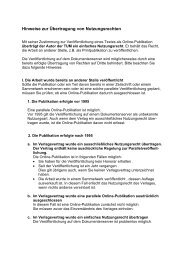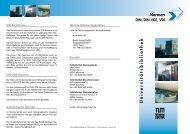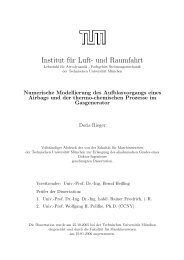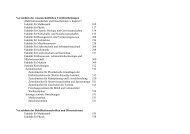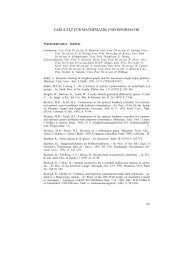LES of shock wave / turbulent boundary layer interaction
LES of shock wave / turbulent boundary layer interaction
LES of shock wave / turbulent boundary layer interaction
You also want an ePaper? Increase the reach of your titles
YUMPU automatically turns print PDFs into web optimized ePapers that Google loves.
9<br />
under free-stream conditions M ∞ = 2.95 and Re δ0 = 63560 (Zheltovodov<br />
& Yakovlev, 1986). A constant-current hot-wire measurement<br />
was employed to obtain total temperature and mass-flux fluctuations,<br />
based on the technique <strong>of</strong> Kovasznay (1953). The mass-flux fluctuation<br />
was decomposed into density and velocity fluctuations using the strong<br />
Reynolds analogy. The mean skin-friction measurements were performed<br />
by the Global Interferometry Skin Friction technique (GISF) (Borisov<br />
et al., 1993).<br />
Heat transfer measurements for the small model were performed by<br />
Zheltovodov et al. (1987) at free-stream conditions M ∞ = 2.9 , Re δ0 =<br />
86520 and M ∞ = 4, Re δ0 = 100000. The data include adiabatic and<br />
heated-wall temperature distributions and the heat transfer coefficient.<br />
An experimentally obtained flow field structure and the measurement<br />
stations are sketched in figure 1.4 for a 25 ◦ -degree compression<br />
ramp. The positions <strong>of</strong> the stations in terms <strong>of</strong> the downstream coordinate<br />
measured along the wall from the compression corner position,<br />
are summarized in table 1.1. Obviously, the big model allowed more<br />
detailed measurements <strong>of</strong> the mean flow. The Reynolds numbers based<br />
on the undisturbed <strong>boundary</strong> <strong>layer</strong> thickness are Re δ0 = 144000 and<br />
Re δ0 = 63560 for big and small models respectively. Despite <strong>of</strong> significant<br />
Reynolds number differences, the mean flow structure is rather<br />
similar if scaled in δ 0 as shown by Zheltovodov & Yakovlev (1986), so<br />
both experiments may be used together for a detailed analysis.<br />
1.3 Prediction capabilities<br />
As pointed out by Dolling (1998, 2001) and confirmed by a more recent<br />
comprehensive analysis (Knight et al., 2003) the numerical prediction <strong>of</strong><br />
SWTBLI by statistical turbulence modeling is yet unsatisfactory. For<br />
situations with <strong>shock</strong>-induced flow separation computational results employing<br />
Reynolds-averaged (RANS) turbulence modeling exhibit a large<br />
scatter <strong>of</strong> predicted separation lengths for various geometrical configurations.<br />
Although numerous computations based on the Reynoldsaveraged<br />
Navier-Stokes equations (RANS) have been performed, currently<br />
only weak and moderate <strong>interaction</strong>s, characterized by low supersonic<br />
Mach number or small flow deflection angles, can be predicted by<br />
RANS computations without specific a posteriori adjustment <strong>of</strong> turbulence<br />
models. For strong <strong>interaction</strong>s, the results <strong>of</strong> RANS computations<br />
show generally a significant disagreement with experimental data



